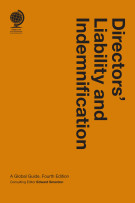Insolvency Office Holder Regulation Worldwide: An Assessment
20 March 2017

Author bio coming soon

Author bio coming soon
In our latest blog, Paul Omar, A Member of the European Commission Experts Group on Restructuring and Insolvency and David Burdette, Senior Technical Research Officer at INSOL discusses the state of insolvency office holder (“IOH”) regulation.
The state of insolvency office holder (“IOH”) regulation worldwide is a matter of some concern to the international bodies active in the insolvency field. The European Bank of Reconstruction and Development held a conference on 7 November 2014 to disseminate the findings of a two-year project into the IOH regulatory environment in its client group, of which 27 out of 35 were the subject of an assessment. While the laws of many of these states have been the subject of domestic scrutiny with a view to reforms to insolvency practice frameworks, this assessment was apparently the first time that research had been undertaken into the structure of the IOH profession in many of these jurisdictions. As such, the holistic view enabled as a result of the work contains some interest for those keen on understanding how IOH regulation is performing worldwide, especially in the European Union, of whose members, some 10 were surveyed, most of which were drawn from the 13 countries acceding between 2004-2013 (the exceptions being Malta, Cyprus and the Czech Republic).
The most essential component of the project’s findings was the great diversity in terms of status, qualification and training of insolvency practitioners, and the framework for their registration, supervision and discipline. Nonetheless, some indications of cross-jurisdictional trends in these countries was possible, a notable example being that where a self-regulatory model or state-sponsored regulatory agency was used, there was a strong correlation with performance overall across the criteria being measured. While most states had a licencing regime in place, less performing countries tended to include those where Government directly exercised supervision over the profession or no regulatory framework existed at all. The tension between private and public control was evident in a number of the jurisdictions surveyed.
Overall, while minimum educational standards and professional entrance exams were often prescribed, the project revealed weak performance in areas such as continuing professional development and training needs. Similarly, lacunae also existed at the level of the development of professional associations and of ethical rules. In many places, however, even where regulatory regimes were sufficiently robust, issues with resources tended to restrict active supervision of IOHs to the context of individual proceedings with the effectiveness of such monitoring dependent on the courts’ own supervisory capacity. The role of the courts in the conduct of proceedings was also identified as an issue, particularly in the balance of control and supervision between creditors and the courts. Over-monitoring was stated as potentially a problem where it inhibited IOHs in the performance of their duties. Finally, the structure of the appointments system in cases, as well as remuneration, were felt to be insufficiently encouraging of competition in the market for IOH services. In summary, the terms of the report revealed that there was much to do in relation to improving the environment and framework for practice in almost all of these states.
Some of the issues reflected in the EBRD assessment had been anticipated in work carried out by the professional associations, including INSOL Europe, which as representative of the European insolvency community, has a watching brief on behalf of their membership over matters connected with reforms to insolvency law and practice. Although written in the context of the then anticipated review of the European Insolvency Regulation, INSOL Europe authored a report in April 2010 on the topic of harmonisation, titled: “Harmonisation of Insolvency Law at EU Level”). This report was presented to the European Parliament Committee on Legal Affairs and largely advocated consideration of substantive harmonisation in a number of areas of insolvency law.
In dealing with insolvency practice qualifications, however, the report concluded that the different systems, especially for remuneration, in the member states surveyed did not cause any difficulties, obstacles or disadvantages for companies with a cross-border dimension operating in the European Union. Harmonisation of this area was not deemed necessary pending greater harmonisation in the insolvency and company law fields. Nonetheless, an issue of concern, which has been reflected in work commissioned by INSOL Europe from the Leiden Law School, is that of a possible ethical code at European level for IOHs. The work has now resulted in the production of a set of IOH Principles and Best Practices that are still being reviewed for adoption by the professional body.
By way of contrast, however, the European Parliament’s Lehne Report in October 2011, which also picked up the harmonisation theme for insolvency law, did consider it worthwhile to deal with insolvency practice qualifications, insofar as qualification and competence were concerned. Other issues to which reference was made included the desirability of good reputation, independence and the need to avoid conflicts of interest. A small jump from the European Parliament’s position saw IOH regulation appearing as one of the sub-themes in a project on “Substantive Insolvency Law and the Prospects for Greater EU Harmonisation”, which was funded by the European Commission and carried out by the University of Leeds. In this project, which arose from the need to analyse member state compliance with the March 2014 Recommendation on a New European Approach to Business Failure and Insolvency, mention is made of the need potentially to re-examine the “caution” explicit in the 2010 INSOL Europe report.
In fact, the IOH-related component of the Leeds study has ended up being reflected in the scope of the Experts’ Group on Restructuring and Insolvency, which began its work in January 2016. The (ambitious) mission of the group includes the development of, inter alia, common principles and rules in areas connected to insolvency, such as the qualifications of insolvency practitioners. Title IV of the draft Directive, produced in November 2016 on the basis of the group’s work, contains measures constituting first steps in the formation of common European standards on IOH qualification and practice. These measures address, inter alia, nomination, continuing professional qualification and remuneration for IOHs that may be appointed as part of early restructuring efforts, although the principles are applicable to professionals working across the insolvency sector.
Overall, given the interest shown by the various international bodies noted above, the insolvency practitioner regulation project (“IP Project”) was conceived in 2015 and launched in 2016. It is an international collaborative project involving the Centre for Business and Insolvency Law at Nottingham Law School, the Business Law Research Centre at Radboud University Nijmegen, the Centre for Advanced Corporate and Insolvency Law at the University of Pretoria and the Commercial and Property Law Research Centre at the Queensland University of Technology. The project has received funding from INSOL International and has the support of both that organisation as well as some interest shown in the project by the World Bank.
The intention behind this project, which is in its first phase, is to conduct a global survey of some 40 countries in four regions around the world, including those from the emerging, developing and developed worlds, to ascertain trends in regulation under a number of practice-related headings, including selection and appointment, qualification, remuneration, liability, removal and replacement as well as supervision frameworks. With the information collected, a series of reports will be produced dealing with regional trends as well as common developments across each category (emerging, developing and developed). The initial findings of all the reports are intended to be presented at the INSOL International Sydney Conference in March 2017 with regional findings being presented at appropriate events thereafter.
Ultimately, the intention of the IP Project is to make recommendations for minimum standards of regulation appropriate for jurisdictions at various stages of development and to feed into the process by which such standards are developed, including that within the European Union, where, as mentioned above, steps have now been taken towards harmonisation on the basis of minimum standards. A further phase of the IP Project’s work will seek to actively engage with the international bodies and key stakeholders with view to achieving the goals of the project.
In summary, the framework for practice for IOHs in in a state of some flux. While individual states may be making advances in regulation to deal with particular problems, there is as yet no overall sense of whether it is desirable for there to be closer convergence between regulatory models and practices on a regional or even global scale. The IP Project will hopefully, however, point the way to understanding the critical issues that will face those desiring to improve standards and the benchmarks for practice. In the long run, improvements to practice frameworks can only be of benefit to debtors, creditors and other insolvency stakeholders alike.













Any comments - send us an email